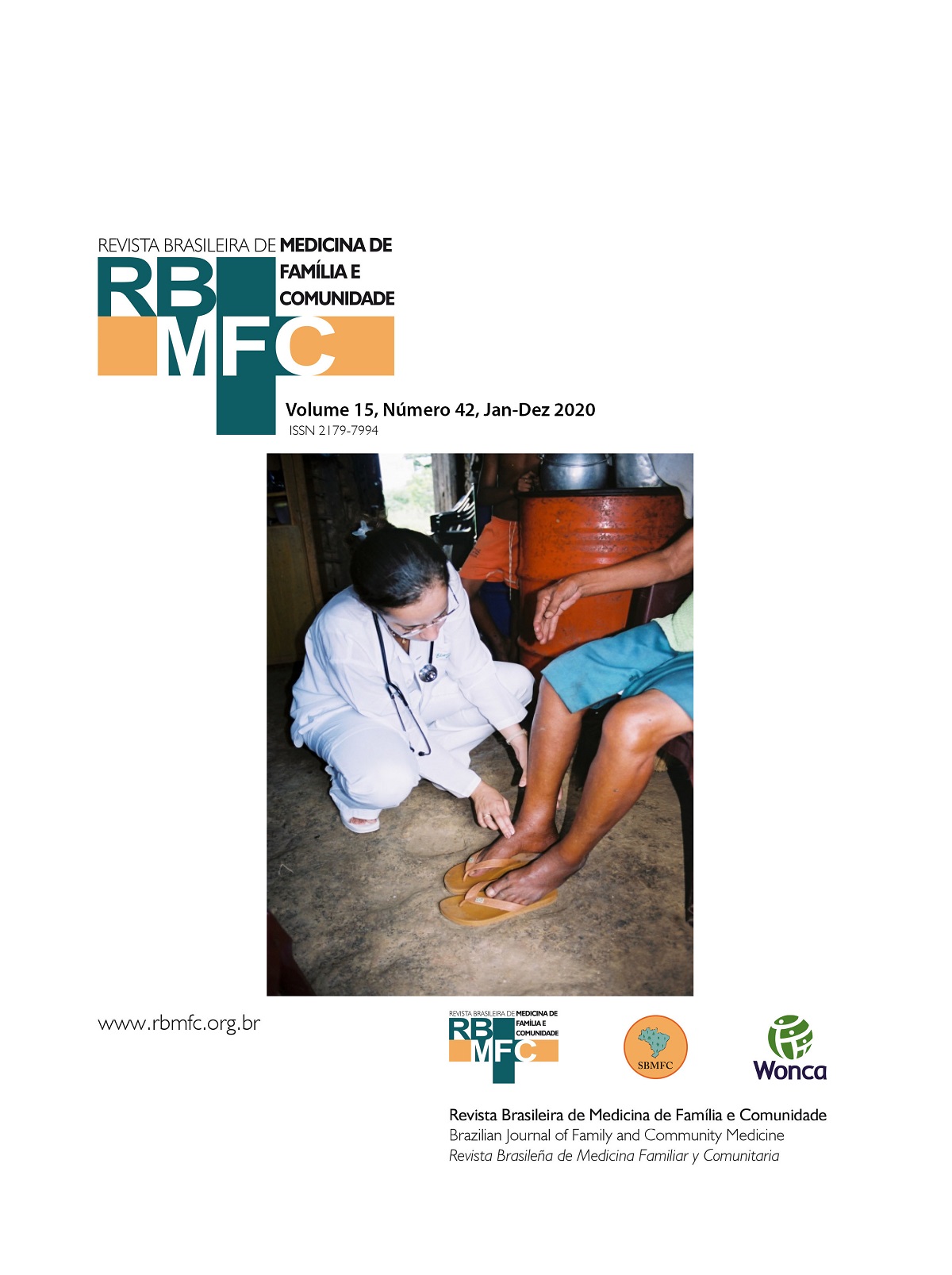Decreased use of alcoholic beverages and intimate partner violence
DOI:
https://doi.org/10.5712/rbmfc15(42)2263Keywords:
Alcoholism, Alcohol Abstinence, Intimate Partner Violence.Abstract
Introduction: Intimate partner violence refers to the behavior of intimate partners or ex-partners resulting in physical, sexual, or psychological harm, including physical aggression, sexual coercion, psychological abuse, and controlling behavior. It is known that alcoholism is associated with increase of this type of violence. Objective: The aim of this study was to analyze whether the partner of the patient in alcohol withdrawal reported a lower rate of violence in this period compared with the period of alcohol abuse. Methods: cross-sectional study in which we selected male former drinkers attended at the CAPSad of Maringá, and their partners. A questionnaire regarding partner violence (HITS), consisting of 4 objective questions with scores ranging from 4 to 20, was used. Values equal to or greater than 10 indicate violence. Results: We interviewed 53 women of different ages and schooling. Of this total, 84.9% of the participants had scores in the test with the partner in withdrawal lower than in the period in which he was in use/abuse of alcohol. 15.1% of the women did not notice a difference in the level of violence of their partners, whether he was in use or withdrawal. Conclusions: It was clearly demonstrated that the cessation of alcohol consumption reduced the rate of violence inflicted by the partner.
Downloads
Metrics
References
(1) Netto L de A, Moura MAV, Queiroz ABA, Tyrrell MAR, Bravo M del M. Violência contra a mulher e suas consequências. Acta Paul Enferm [Internet]. 2014;27(5):458–64. Available from: http://dx.doi.org/10.1590/1982-
(2) Vieira LB, Cortes LF, Padoin SM de M, Souza IE de O, Paula CC de, Terra MG. Abuso de álcool e drogas e violência contra as mulheres: denúncias de vividos. Rev Bras Enferm. 2014;67(3):366–72.
(3) Smith PH, Homish GG, Leonard KE, Cornelius JR. Intimate partner violence and specific substance use disorders: Findings from the National Epidemiologic Survey on Alcohol and Related Conditions. Psychol Addict Behav. 2012;26(2):236–45. DOI: https://doi.org/10.1037/a0024855 DOI: https://doi.org/10.1037/a0024855
(4) Cunradi CB, Mair C, Todd M. Alcohol Outlet Density, Drinking Contexts and Intimate Partner Violence: A Review of Environmental Risk Factors. J Drug Educ. 2014;44(0):19–33. DOI: https://doi.org/10.1177/0047237915573527 DOI: https://doi.org/10.1177/0047237915573527
(5) Wilson IM, Graham K, Taft A. Alcohol interventions, alcohol policy and intimate partner violence: a systematic review [Internet]. 2014. Available from: http://www.biomedcentral.com/1471-2458/14/881 DOI: https://doi.org/10.1186/1471-2458-14-881 DOI: https://doi.org/10.1186/1471-2458-14-881
(6) Afifi TO, Henriksen CA, Asmundson GJG, Jitender S. Childhood Maltreatment and Substance Use Disorders Among Men and Women in a Nationally Representative Sample [Internet]. Vol. 57, The Canadian Journal of Psychiatry. 2012. Available from: www.TheCJP.ca DOI: https://doi.org/10.1177/070674371205701105 DOI: https://doi.org/10.1177/070674371205701105
(7) Chamorro J, Bernardi S, Potenza MN, Grant JE, Marsh R, Wang S, et al. Impulsivity in the general population: A national study. J Psychiatr Res. 2012;46(8):994–1001. DOI: https://doi.org/10.1016/j.jpsychires.2012.04.023 DOI: https://doi.org/10.1016/j.jpsychires.2012.04.023
(8) Silva ACLG, Coelho EBS, Moretti-Pires RO. O que se sabe sobre o homem autor de violência contra a parceira íntima: uma revisão sistemática. Vol. 35, Rev Panam Salud Publica. 2014.
(9) Miot HA. Tamanho da amostra em estudos clínicos e experimentais. J Vsac Bras. 2011;10(4):275–8. DOI: https://doi.org/10.1590/S1677-54492011000400001 DOI: https://doi.org/10.1590/S1677-54492011000400001
(10) Sherin KM, Sinacore JM, Li XQ, Zitter RE, Shakil A. Hits: A short domestic violence screening tool for use in a family practice setting. Fam Med. 1998 Jul;30(7):508–12.
(11) Iverson KM, King MW, Gerber MR, Resick PA, Kimerling R, Street AE, et al. Accuracy of an Intimate Partner Violence Screening Tool for Female VHA Patients: A Replication and Extension. J Trauma Stress [Internet]. 2015 Feb;28(1):79–82. Available from: http://doi.wiley.com/10.1002/jts.21985 DOI: https://doi.org/10.1002/jts.21985 DOI: https://doi.org/10.1002/jts.21985
(12) Singh V, Petersen K, Singh SR. Intimate partner violence victimization Identification and response in primary care. Vol. 41, Primary Care - Clinics in Office Practice. W.B. Saunders; 2014. p. 261–81. DOI: https://doi.org/10.1016/j.pop.2014.02.005 DOI: https://doi.org/10.1016/j.pop.2014.02.005
(13) Chen PH, Jacobs A, Rovi SL. Intimate partner violence: office screening for victims and perpetrators of IPV. FP Essent. 2013;412:11–7. PMID: 24053260
(14) Fonsêca L de MA. Tradução, adaptação cultural e propriedades psicométricas da hurt insult threatened scream para rastreio da violência doméstica contra idosos no Brasil [Internet]. Santa Cruz; 2018. Available from: https://repositorio.ufrn.br/jspui/bitstream/123456789/25211/1/LuizaDeMarilacAlvesDaFonseca_DISSERT.pdf
(15) Ally EZ, Laranjeira R, Viana MC, Pinsky I, Caetano R, Mitsuhiro S, et al. Intimate partner violence trends in Brazil: data from two waves of the Brazilian National Alcohol and Drugs Survey. Rev Bras Psiquiatr. 2016;38:98–105. DOI: https://doi.org/10.1590/1516-4446-2015-1798 DOI: https://doi.org/10.1590/1516-4446-2015-1798
(16) WHO | Global status report on violence prevention 2014. World Health Organization. Geneva: World Health Organization, United Nation Development Programme, United Nations Office on Drugs and Crime; 2014.
(17) Flake DF. Individual, family, and community risk markers for domestic violence in Peru. Violence Against Women [Internet]. 2005 Mar;11(3):353–73. Available from: http://www.ncbi.nlm.nih.gov/pubmed/16043554 DOI: https://doi.org/10.1177/1077801204272129 DOI: https://doi.org/10.1177/1077801204272129
(18) Jewkes R, Sikweyiya Y, Morrell R, Dunkle K. Understanding men’s health and use of violence: interface of rape and HIV in south Africa. MRC Policy Brief. Pretoria; 2009.
Downloads
Published
How to Cite
Issue
Section
License
By submitting a manuscript to the RBMFC, authors retain ownership of the copyright in the article, and authorize RBMFC to publish that manuscript under the Creative Commons Attribution 4.0 license and identify itself as the vehicle of its original publication.















